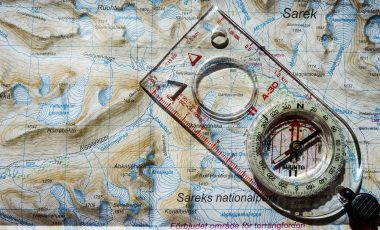Navigation is an intrinsic part of many outdoor activities making understanding what the different parts of a compass are and how to use one, rather useful! You’ll often need to find your own way to your destination and get safely home again. Yes, there are marked trails to follow, but well-marked routes are often busy, and, as the saying goes, the real adventure starts where the trails end.
For many people, navigation means opening a phone app or using a GPS. And while these devices can be incredibly accurate, they are not 100% reliable. For example, phone batteries and chargers die unexpectedly, and GPS signals can drop out.
So, whether you use one as a backup or your primary method of navigation, all outdoor enthusiasts should carry and be able to use a compass. Learning to use a compass takes time, and it’s a skill you’ll lose if you don’t use it.
In this article, we explain the basic parts of a compass, which is a prerequisite for mastering navigating with a compass. We’re also going to talk about the different types of compasses.
What is a compass, anyway?
Broadly speaking, a compass is a device that indicates north. Once you know which direction north is, you can easily identify where east, south, and west are.
Most compasses use magnetised needles, which naturally point toward magnetic north. However, there are electronic compasses that use Global Positioning Systems or GPS to locate north and have LCD displays instead of the more traditional rotating compass dial and compass rose.
Compasses are not a new invention and actually date back over 2,000 years. The ancient Greeks are believed to have discovered magnetism and the Earth’s magnetic fields.
Records suggest that 12th-century Chinese scientists rubbed iron bars together to magnetise them for navigational purposes. They also used naturally magnetic minerals called lodestones to magnetise needles which they then floated on water or suspended on silk threads.
Early compasses showed only the four cardinal directions, i.e., north, south, east, and west. But, as technology improved, the compass roses evolved to include more directions. Modern compass dials are divided into 360 degrees, and some offer even smaller navigational increments.
Modern compasses are much more reliable and accurate than a magnetised needle attached to a silk thread but work according to the same principles established all those centuries ago.
Parts of a compass
Don’t know your baseplate from your rotating bezel? Don’t worry – we’re here to help. This is the compass terminology you need to know!
Note: We’re talking about magnetic base plate compasses here, as they are the most widely used for navigation. Other types of compasses have different parts.
Compass parts diagram
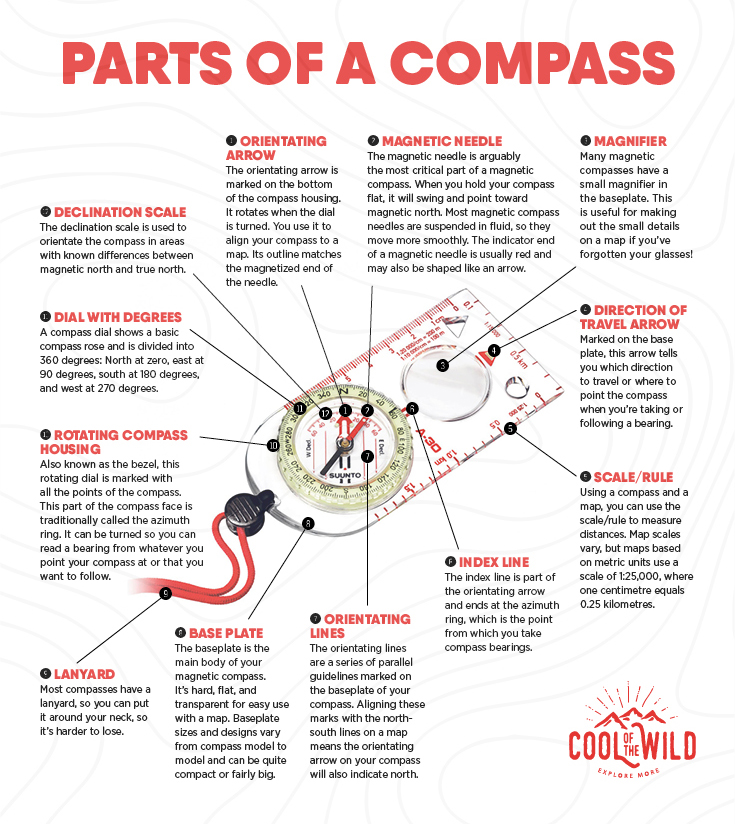
Share this image on your site
What are the parts of a compass?
The basic parts of a compass include:
- Scale/rule
- Direction of travel arrow
- Orientating arrow
- Declination scale
- Dial with degrees
- Index line
- Magnetic needle
- Orientating lines
- Rotating compass housing
- Base plate
- Magnifier
- Lanyard
Parts of a compass, explained
Scale/rule
Using a compass and a map, you can use the scale/rule to measure distances. Map scales vary, but maps based on metric units use a scale of 1:25,000, where one centimetre equals 0.25 kilometres.
Direction of travel arrow
Marked on the base plate, this arrow tells you which direction to travel or where to point the compass when you’re taking or following a bearing.
Orientating arrow
The orientating arrow is marked on the bottom of the compass housing. It rotates when the dial is turned. You use it to align your compass to a map. Its outline matches the magnetised end of the needle.
Declination scale
The declination scale is used to orientate the compass in areas with known differences between magnetic north and true north. Declination varies from place to place and can be as small as a couple of degrees or as high as 20. You can set the declination scale at the start of a journey and then forget about it, as all your compass readings will be adjusted accordingly.
Dial with degrees
A compass dial shows a basic compass rose and is divided into 360 degrees: North at zero, east at 90 degrees, south at 180 degrees, and west at 270 degrees.
Index line
The index line is part of the orientating arrow and ends at the azimuth ring, which is the point from which you take compass bearings.
Magnetic needle
The magnetic needle is arguably the most critical part of a magnetic compass. When you hold your compass flat, it will swing and point toward magnetic north. Most magnetic compass needles are suspended in fluid, so they move more smoothly.
The indicator end of a magnetic needle is usually red and may also be shaped like an arrow. Needless to say, the other end of the magnetic needle points south.
Beware! The direction of the needle can be affected by other magnetic fields, such as the presence of iron and batteries, so make sure you use your compass away from your phone and other sources of interference.
Orientating lines
The orientating lines are a series of parallel guidelines marked on the baseplate of your compass. Aligning these marks with the north-south lines on a map means the orientating arrow on your compass will also indicate north.
Rotating compass housing
Also known as the bezel, this rotating dial is marked with all the points of the compass. This part of the compass face is traditionally called the azimuth ring. It can be turned so you can read a bearing from whatever you point your compass at or that you want to follow.
Base plate
The baseplate is the main body of your magnetic compass. It’s hard, flat, and transparent for easy use with a map. Baseplate sizes and designs vary from compass model to model and can be quite compact or fairly big.
Magnifier
Many magnetic compasses have a small magnifier in the baseplate. This is useful for making out the small details on a map if you’ve forgotten your glasses!
Lanyard
The last thing you want when you are out adventuring is to lose your compass. Most compasses have a lanyard, so you can put it around your neck, so it’s harder to lose. At the very least, you should loop your compass lanyard around your wrist when you are using it so you can’t drop and break it.
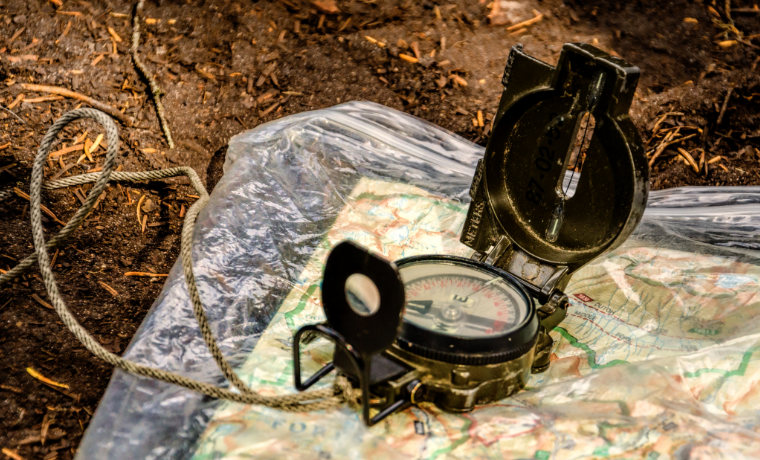
Types of compasses
While most people are familiar with magnetic baseplate compasses, that’s not the only navigational compass in use today. There are several other compass designs.
The 12 most common types of compass are:
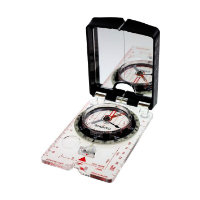
01Mirrored compass
Mirrored compasses have a flip-up mirror/viewfinder to make taking bearings on distant objects easier. The mirror can also be used for signalling in an emergency.

02Lensatic compass (prismatic compass)
Lensatic or prismatic compasses are commonly used in the military. They have a liquid-filled body with two perpendicular glass plates that magnify the compass rose and needle inside. They usually have a flip-up sight for taking accurate bearings on distant targets.
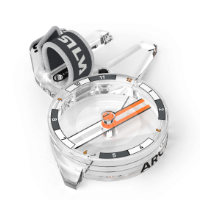
03Thumb compass
A thumb compass is a small magnetic compass with a built-in thumb loop that saves you from holding your compass in the palm of your hand. Thumb compasses are popular with orienteers and mountain marathon runners as they can be used “on the go.”
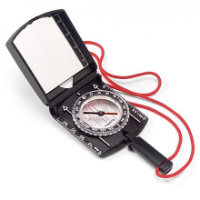
04Liquid-damped compass
Many magnetic compasses contain liquids which act as dampeners to ensure the needle moves smoothly and accurately. Liquid-damped compasses tend to be accurate and less influenced by external forces, such as nearby magnetic fields or movement.
What fluid is in a liquid-damped compass? Good question! The liquids vary and include:
Purified kerosene
- Lamp oil
- Mineral oil
- Mineral spirits
- Ethyl alcohol

05Gyrocompass
Gyrocompasses are usually big and bulky and are not commonly used for land navigation. Instead, they’re usually used on ships. A gyrocompass consists of a high-speed spinning wheel or ball and uses the law of conservation of angular momentum to point towards true north rather than magnetic north.
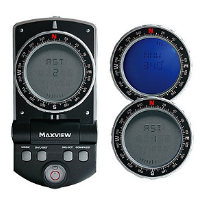
06GPS compass
GPS compasses get their information from a series of earth-orbiting satellites. While GPS compasses can be accurate to within a couple of meters, they aren’t 100% reliable as satellite coverage varies from region to region, and device batteries can fail.
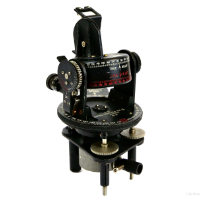
07Astro compass
Astro compasses determine true north from the position of the sun, stars, and other celestial bodies. They’re commonly used at sea, by surveyors, and by anyone who can’t afford to have their readings affected by magnetic variances.
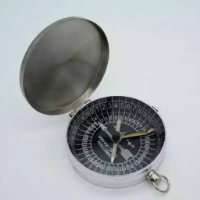
08Qibla compass
A qibla compass is used by Muslims to locate Mecca so they face the right way for their daily prayers.

09Solid-state compass
Solid-state or electric compasses are built into devices like phones, tablets, and other smart devices. They measure the strength and direction of Earth’s magnetic field to determine which way is north.

10Surveyor’s compass
Surveyor’s compasses are very accurate and used when a high degree of precision is required. A surveyor’s compass measures bearings and angles and consists of a needle that is free to rotate on a pivot point, so it moves around and up and down.
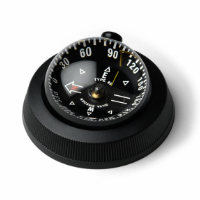
11Card compass
Card compasses, also known as marine compasses, are commonly used on ships and boats. They have a fixed needle or indicator line and use a moving compass card for directional readings. Card compasses are filled with fluid to absorb the motion of the boat and keep the compass card steady and easy to read.
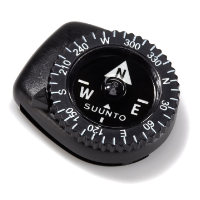
12Button compass
Button compasses are very small – often not much bigger than the end of a finger. They’re not especially accurate and really only useful in emergency situations for getting a general idea of where north is. However, as a backup, they can be useful and worth keeping in your pocket or backpack.
Closing thoughts on compass parts and types of compasses
Now you know the parts of a compass, you should find instructions on navigating with a compass much simpler to follow. So, commit this compass anatomy lesson to memory, but remember that not all compasses are the same, and some have features that others don’t. For example, more basic models don’t have magnifiers.
Regardless of the type you use, familiarity with these compass terms will make learning to use a compass much easier.


